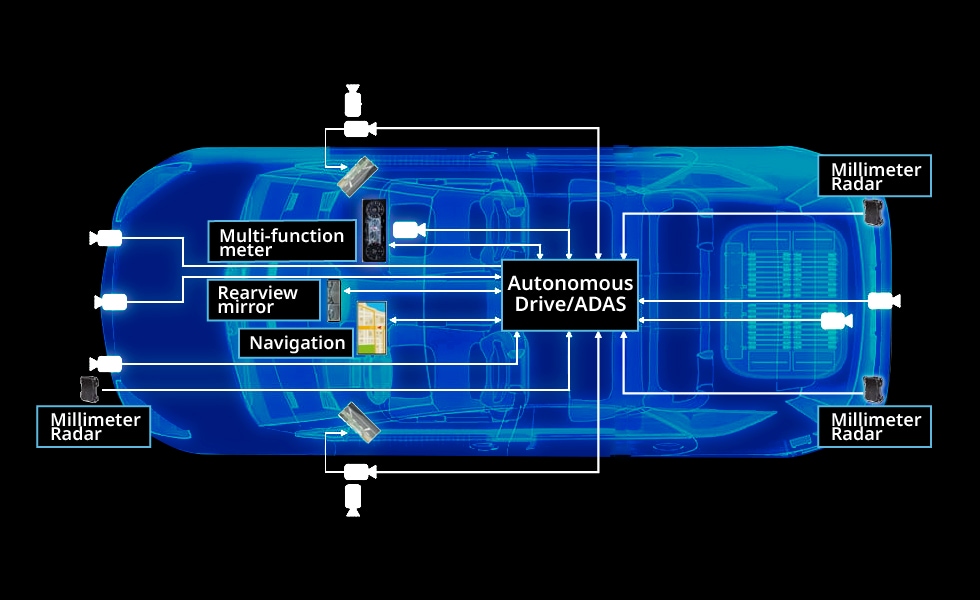

Advanced PoC Filters Underpin Automotive Onboard Camera Networks
Among the most prominent automotive technologies today is ADAS (Advanced Driver Assistance Systems). With the ongoing evolution of ADAS—which employs cameras and sensors to sense the vehicle’s surroundings in place of the human eye—cars equipped with onboard cameras and high-performance radars are becoming more prevalent. Because ADAS and autonomous driving require the sensing of vehicle conditions during high-speed travel as well as real-time data processing, the performance of in-vehicle networks is a determinant of a car’s overall performance.
The PoC approach to in-vehicle networks
Cars outfitted with a multitude of electronic devices, including cameras and sensors, are interlaced with in-vehicle networks to support functions like autonomous driving, ADAS, and infotainment systems. In many cases, data from cameras and radars are transmitted using a method known as PoC (Power over coax), where a single coaxial cable carries both data and power. This approach requires less cabling than transmitting data and power separately, offering benefits like reduced vehicle weight and simplified wiring.
▶Related Story:
The Role of Noise Filters, Essential to the Advancement of In-Vehicle Networks
PoC-based transmission networks for camera and radar data

Advantages of PoC communications

Role of inductor components in PoC communications
PoC-based communication systems require PoC filters to separate the superimposed data and power prior to signal processing. PoC filters comprise one or more inductors*1, ensuring high impedance*2 across a broad frequency range to separate data and power properly.
Configuration of a PoC filter

In ADAS and automated driving—which require continuous, rapid processing of vast amounts of information generated by increasingly high-performance cameras and radars—the inability to transmit data accurately can lead to serious accidents. This is why it is critical to select appropriate PoC filters to maintain stable communication quality and data transmission integrity.
▶Related Article:
How to select the right PoC Filter Inductors and Chip Beads for Automotive SerDes (LVDS) Transmission
TDK’s PoC filters, enabled by proprietary inductor technology
TDK has a history of developing inductors optimized for PoC filters. For example, the ADL series of PoC inductors delivers high impedance characteristics over a wide frequency range, reducing the number of inductors needed to configure PoC filters.

Their small mounting area accommodates increasingly compact camera modules. Products operable at temperatures up to 155°C are also available, enabling the proposal of solutions capable of handling large currents even in high-temperature conditions.
Photo: ADL 3225VM series of automotive PoC inductors

CTO, Magnetics BG
TDK Corporation
Nobuo Kitajima, CTO of TDK Corporation’s Magnetics BG, discussed the technology and the value of TDK’s inductors designed for PoC. “Advancements in automotive autonomous driving technology have elevated the importance of sensing technologies like onboard cameras. PoC technology plays a critical role in this context, as it powers the sensors while transmitting the data, without degradation, to the ECUs. Inductors used in PoC must perform equally well as power inductors and as noise-suppressing filters. We also believe it is important to provide our customers comprehensive technical services that measure performance accurately and propose solutions for ensuring correct performance, including optimal component placement and wiring.”
Kitajima continued, “TDK has developed and brought to market a variety of inductors, including wire wound, multilayer, and thin film designs. We even have a dedicated team that evaluates the performance and packaging of PoC filters. We are confident in our ability to offer customers the comprehensive technology and services required to meet the needs of passive components for sensing technologies, which are expected to become increasingly high-performance.”
TDK’s inductor products designed for PoC

Through years of inductor development, TDK has assembled a broad lineup of products featuring a variety of characteristics to meet diverse demands, including high-speed communication, large current applications, and high-temperature environments. As onboard cameras, radars, and sensors advance and autonomous driving technology grows more sophisticated, TDK continues to underpin new possibilities in mobility through its electronic components designed for in-vehicle networks.
Watch a promotional video showcasing the inductors for automotive PoC designed for in-vehicle networks featured in this story.
Terminology
- Inductor: An electronic component that exhibits high impedance against alternating current and low resistance to direct current. This characteristic is utilized to separate signals from electrical power when the two are transmitted together.
- Impedance: The overall resistance that obstructs the flow of electrical current in an alternating current circuit. It includes resistance (R) and reactance (X).


















